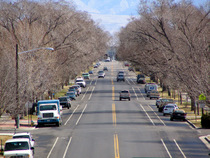Arterial Operations Pavement and Access Management
Pavements and Access Management
 This strategy paper analyzes potential strategies that may be deployed in northeastern Illinois on our arterial highway system. The purposes of the each strategy may vary, but the overall goal of such strategies would be to reduce vehicle delay, reduce crashes, facilitate economic development, improve reliability, and improve walkability and bikeability.
This strategy paper analyzes potential strategies that may be deployed in northeastern Illinois on our arterial highway system. The purposes of the each strategy may vary, but the overall goal of such strategies would be to reduce vehicle delay, reduce crashes, facilitate economic development, improve reliability, and improve walkability and bikeability.
Physical and operational improvements to the arterial system can improve capacity, improve travel time reliability and reduce crashes. These strategies may require large capital outlay to facilitate, and may require a higher on-going commitment to supporting a cadre of qualified professionals to operate the facility.
Table of Contents
-
Part 1: Pavements
- Pavement Management
- Roadway and Lane Width
- Number of Motor Vehicle Traffic Lanes
- Median Treatments
-
Part 2: Access Management
- Specialized Roadway System
- Limit Direct Access to Major Roadways
- Promote Intersection Hierchy
- Locate Signals to Favor Through Movements
- Intersections and Interchanges
- Conflict Points
- Turning Vehicles
- Medians for Left-turn Movements
- Supporting Street and Circulation System
- Benefits of Access Management
- Regional Role of Access Management
For highways, the biggest investments are typically in pavement, structures, and drainage. However, good physical infrastructure is not sufficient to achieve our regional vision. Access management, "complete street" elements, technologies, and intersection operations will also be considered. Pavements and access management will be considered first, in this document. Successive documents will consider complete streets, technologies, and intersection operations. Drainage and structures are not a central theme of these papers, but will be considered as part of other discussions.
A sample of findings:
- Adopting a narrow street standard for local streets reduces long-term maintenance costs of unnecessary pavement and reduces stormwater management expenses and impacts
- Downers Grove reduced crashes on Fairview Avenue by 47% by adding continuous left-turn lane to the two-lane avenue
- A highway access classification system based not only on transportation but also land use, facilitated the achievement of land use goals while simultaneously proving a more consistent, enforceable, and effective access management standard.
If you're interested in learning more about pavements and access management, please review the following CMAP strategy report. Comments and criticisms are encouraged.
|
Links |